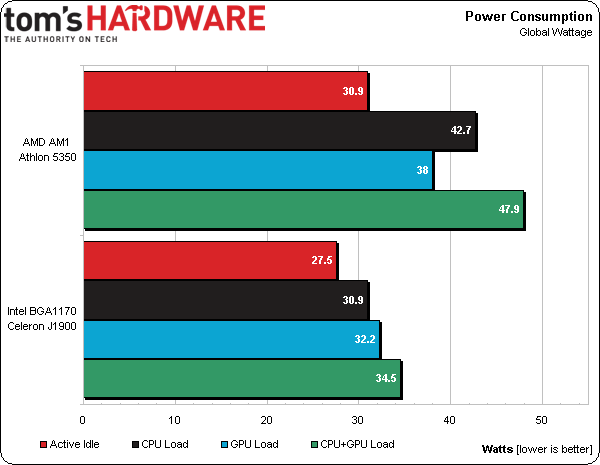AMD Athlon 5350 And AM1 Platform Review: Kabini In A Socket
AMD is repackaging the mobile-focused Kabini APU for use on the desktop, and tucking them under the familiar Athlon and Sempron brands. We take a closer look at the company's socketed AM1 platform and compare its performance to Intel's Bay Trail-D.
Power And Temperature
At first glance, it looks like the Athlon 5350 uses significantly more power than Intel's Celeron J1900, especially when it comes to the combined CPU and GPU load. But even in that extreme case, only 13 W separate the two platforms.
To put our measurements into perspective, many high-end desktop PCs use more power at idle than these systems under the most taxing load we can contrive.
When they drop down to idle, these systems are separated by a negligible 3.5 W.
As for thermals, Intel appears to fare quite a bit worse. But bear in mind that the Celeron J1900 is using a passive heat sink, whereas the Athlon benefits from active cooling.
Intel comes away with the advantage then, as its highly-integrated motherboard/processor combo generates no noise and won't accumulate dust.
Get Tom's Hardware's best news and in-depth reviews, straight to your inbox.
Current page: Power And Temperature
Prev Page Game Benchmarks Next Page AMD's AM1 Platform Is A Winner, But Who Is Playing The Game?Don Woligroski was a former senior hardware editor for Tom's Hardware. He has covered a wide range of PC hardware topics, including CPUs, GPUs, system building, and emerging technologies.
-
AMD Radeon i hope mini office pc box can be a new trendReply
AM1 can be a potential winner in this market -
Maxx_Power To Toms:Reply
What was the ambient temperature during the testing ? Surely Toms is not testing in an refrigerator ? That idle GPU and CPU temperature at 13 degrees Celsius seems about 10 degrees too low, given that they have to be necessarily above ambient conditions to make physical sense. Perhaps the sensors are not read correctly (wrong offset) ?
For the Dota2 graphs, there seems to be a mistake for the color legend. The difference in color isn't resolution, since the resolution is fixed (right hand top corner of graph at 1080), so my guess is that red/black represents min/avg FPS similar to the 2nd graph on Grid2.
-
nezzymighty Thanks for the article. I agree with your conclusion, as I would probably seek an alternative build for a a "PC-Like Device" as you put it. Seeing AM1 product costs relatively the same to an A4-4000 FM2+ confuses me, as I had originally expected (hoped) AM1 high-end combinations with a motherboard to cost around the $70 mark... If I were to make an AMD HTPC, or a typical AMD business computer, based on prices released by the e-tailers today, it would make more sense for me to build an FM2+ with A4-4000. Maybe prices will reduce in time to make this a more attractive alternative relative to an FM2+ for an HTPC or business computer.Reply -
ykki "Based on our results, I'd guess that AMD's AM1 platform should be able to handle less-demanding MMOs like World of Warcraft, lightweight shooters like Left 4 Dead, and a wide range of even more casual games (such as Angry Birds)."Reply
I think that it is safe to say that it can max out angry birds at 4k :) -
cleeve Reply13061890 said:To Toms:
What was the ambient temperature during the testing ? Surely Toms is not testing in an refrigerator ? That idle GPU and CPU temperature at 13 degrees Celsius seems about 10 degrees too low, given that they have to be necessarily above ambient conditions to make physical sense. Perhaps the sensors are not read correctly (wrong offset) ?
On-die sensors are notoriously inaccurate at low temperatures. In this case that's obvious, but we can only report what the sensors tell us.
13061890 said:For the Dota2 graphs, there seems to be a mistake for the color legend. The difference in color isn't resolution, since the resolution is fixed (right hand top corner of graph at 1080), so my guess is that red/black represents min/avg FPS similar to the 2nd graph on Grid2.
Good catch! Fixed. :)

